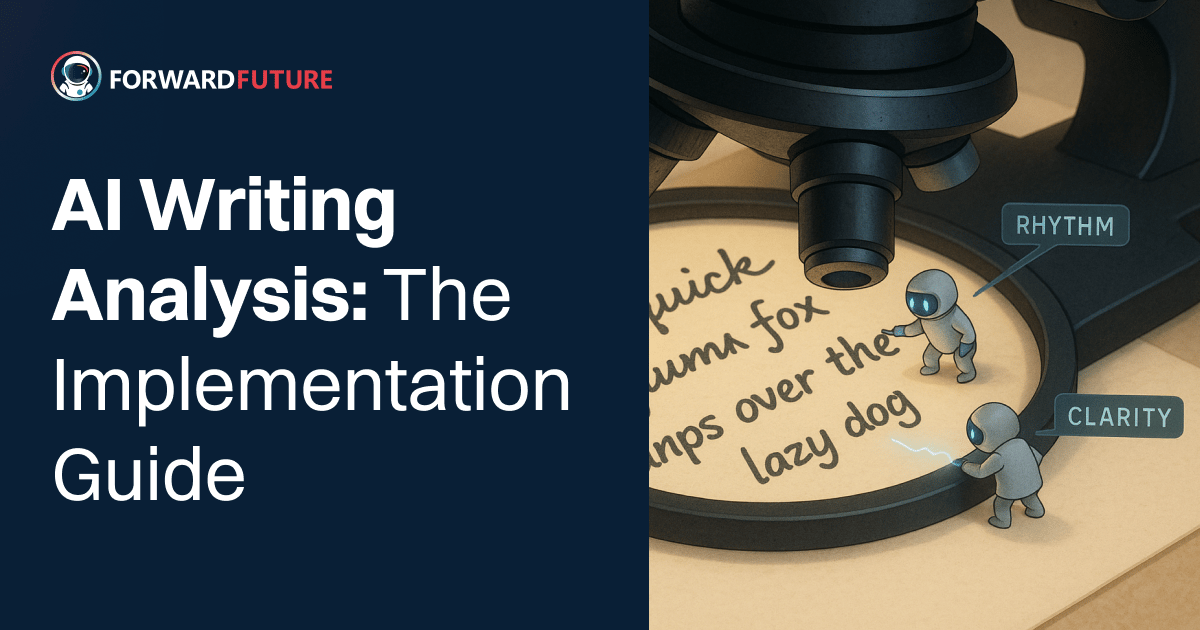
Estimated Read Time: 8 minutes
Remember when "spell check" felt revolutionary? That quaint red squiggly line under misspelled words now seems almost charmingly primitive compared to what's happening in the editorial landscape today.
AI writing analysis has exploded beyond basic proofreading into something far more sophisticated and far more useful. These tools now scrutinize every dimension of your writing: tone, structure, brand voice, even potential bias. For everyone from individual contributors to managers to entire editorial teams, this isn’t just convenient—it’s one of the most effective ways to save hours each week and dramatically improve content quality.
The bottom line: Modern AI can handle the heavy lifting of content analysis, freeing humans to focus on strategy, creativity, and the kind of nuanced judgment that actually moves the needle.
What Modern AI Can Actually Do for Your Writing
Beyond Grammar: The New Frontier
Today's AI writing assistants have evolved into comprehensive content analysts. Here's what they're actually capable of:
Grammar and spelling remain the foundation, but the sophistication has jumped dramatically. These systems catch contextual errors that traditional spell-checkers miss—like distinguishing between "compliment" and "complement" based on meaning, not just spelling.
Tone analysis might be the most game-changing capability. AI can now detect when your marketing copy sounds too corporate for your startup brand, or when a customer service email reads as dismissive rather than helpful. Some tools can even flag emotional undertones you didn't realize were there.
Readability optimization goes beyond grade-level calculations. Advanced systems identify exactly which sentences trip up readers and suggest specific fixes. They'll catch when you've buried your main point in a maze of subclauses—something that happens more often than most writers care to admit.
The Consistency Engine
Here's where AI truly shines: enforcing standards across massive content libraries.
Brand voice consistency used to require armies of editors with hawk-like attention to detail. Now AI can be trained on your style guide and flag deviations instantly. If your company prefers "customer success" over "customer service," the AI remembers. If you've banned corporate jargon like "synergistic solutions," it'll catch those too.
Terminology management becomes automatic. Product names, technical terms, even preferred spellings get standardized across every piece of content. For enterprises publishing hundreds of pieces monthly, this level of consistency was previously impossible to maintain.
The Unexpected Capabilities
Inclusivity screening represents one of AI's most valuable and underutilized features. These systems can flag potentially exclusionary language and suggest alternatives. They catch gendered assumptions, cultural biases, and accessibility issues that human editors might miss.
SEO optimization happens in real-time. AI tools analyze keyword density, suggest semantic variations, and even predict content performance based on search patterns. It's like having an SEO expert reviewing every paragraph.
Plagiarism detection has evolved beyond simple matching. Modern AI can identify paraphrased content and flag when writing is too similar to existing sources—crucial for maintaining originality in an age of AI-generated content.
Implementation: From Pilot to Production
Rolling out AI writing analysis isn't just about buying software, it's about redesigning how you create content. Here's the roadmap that works:
Phase 1: Strategic Assessment
Start by identifying your biggest content pain points. Are you struggling with basic errors, brand consistency, or something else entirely? Different AI tools excel at different problems.
Small teams might start with Grammarly Business for grammar and style. Large enterprises with complex compliance needs often choose platforms like Acrolinx that can handle custom requirements and integration challenges.
Pro tip: Consider your industry's regulatory requirements early. Financial services, healthcare, and legal content often need specialized compliance features.
Phase 2: Pilot and Calibration
Run a controlled pilot with a subset of your team and/or content types. This isn't just about testing features, it's about training the AI to understand your specific needs.
Upload your style guides, brand voice documentation, and terminology preferences. Configure the AI to match your editorial standards. Most enterprise platforms allow extensive customization. Take advantage of it.
During the pilot, pay attention to false positives. If the AI consistently flags acceptable content as problematic, adjust the sensitivity settings or create exceptions.
Upgrade to Premium to continue reading.
Join Forward Future Premium for exclusive access to expert insights, deep dives, and a growing library of members-only content.
UpgradeA subscription gets you:
- “I Will Teach You How to AI” Series
- Exclusive Deep-Dive Content
- AI Insider Interviews
- AI Tool Library
- AI Model Comparison Hub
- AI Job Board (Coming Soon!)

